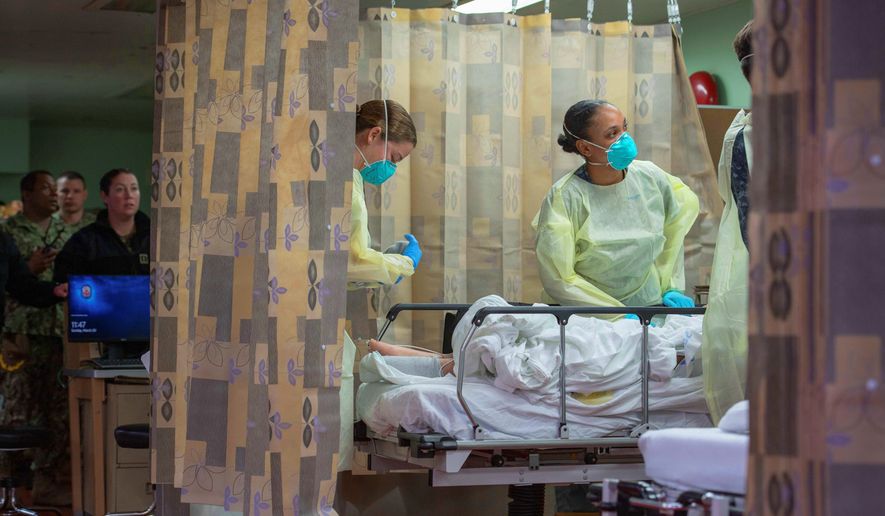Hospitalizations for COVID-19 have spiked in several states amid a surge of new cases of young people becoming infected, forcing government officials to pause or roll back reopening plans.
Health experts worry that younger people, who may develop mild symptoms, if any, are infecting vulnerable populations such as older folks and those with underlying health conditions, who are more likely to experience serious illness and require hospitalization.
“In recent weeks, we’ve seen an influx of young adults, people in their 20s and 30s, principally, maybe up to 40s, and many of them don’t have underlying illnesses. And we think that is a consequence of opening up casually and lots of congregate activities, particularly in bars and similar venues such that the virus is spreading more in that population and obviously making some of those individuals sick enough to require hospitalization,” said Dr. William Schaffner, an infectious disease expert at Vanderbilt University.
“Young people are less apt to get sick than older people, but that doesn’t mean they have a suit of armor that will reject the coronavirus entirely. Young people, even if they don’t get that sick, can spread the virus to people who are going to get very sick,” Dr. Schaffner added.
Many states are recording a large proportion of COVID-19 infections in people under 50 years old.
For example, California, which has recorded more than 347,600 cases as of Wednesday, is reporting that nearly 60% of infections are among 18- to 49-year-olds.
In Arizona, 20- to 44-year-olds account for about 50% of the state’s more than 131,000 coronavirus infections.
Daily new cases in the U.S. are hovering around 60,000 as most states are recording increases in infections, particularly in the South and the West. More than half of the states have recorded increases in hospitalizations lately, according to the InvestigateTV COVID-19 tracker.
Hospitalizations in hot spots including Texas, Arizona, Florida and California, are hitting record highs as new cases trend upwards.
California set a record Wednesday with 8,693 hospitalizations, including 1,907 ICU admissions, state health department data shows. The state had 6,612 hospitalizations at the start of July.
Florida cases jumped almost 1,400 within less than a week, increasing from 6,974 July 10 to 8,354 hospitalizations as of Tuesday. In Arizona, hospitalizations increased from 2,876 July 1 to 3,517 on July 14, data from The COVID-19 Tracking Project shows.
Some national forecasts suggest an increase in new daily hospitalizations over the next four weeks while other forecasts predict stable numbers or slight declines. Forecasts estimate anywhere from 4,500 to 13,000 new daily hospitalizations due to COVID-19 come Aug. 10.
Nationally, the rate is about 107 hospitalizations per 100,000 people, according to the latest data from the Centers for Disease Control and Prevention.
The highest rates are still among people 65 years or older, hovering around 317 hospitalizations per 100,000, followed by 50- to 64-year-olds at 162 hospitalizations per 100,000 people.
For those between 18 and 49 years old, the coronavirus hospitalizes about 67 per 100,000, CDC data for July shows.
Some state officials are reinstating restrictions in response to the surge in cases. Washington Gov. Jay Inslee said Tuesday he would temporarily stop allowing counties to move forward with reopening plans through at least July 28.
On Monday, California Gov. Gavin Newsom ordered all indoor activities at restaurants, theaters, wineries, zoos, bars and museums to close due to the alarming rate of virus spreading.
Oregon Gov. Kate Brown on Monday said she is banning indoor social gatherings of more than 10 people and requiring people to wear face coverings outdoors if they cannot maintain 6 feet of space from others.
Also on Monday, Miami Mayor Francis Suarez said he’s considering imposing another lockdown order as infections climb in Florida.
On Sunday, Florida broke a national record for the highest single-day increase in positive coronavirus cases, adding more than 15,000 infections to the U.S. tally.
In Nevada, 37 bars have filed a lawsuit to combat Gov. Steve Sisolak’s order announced Friday that requires bars in certain counties to shut down, CNN reported.
Although infections have gone up, mortality rates nationwide declined a bit, hitting a low of 209 deaths on July 5 before climbing to more than 900 on July 7. Since then, new deaths have staggered between 300 and 800, says The COVID Tracking Project.
When mortality rates were on the decline, health experts warned that deaths trail behind new infections, which could explain the decrease amid rising infections.
“Deaths are a lagging indicator and we may not see a rise commensurate with the increase in transmission for a few weeks especially since younger people are getting infected and would need time to transmit to a vulnerable individual who would then need more time to become ill,” said Dr. Amesh Adalja, senior scholar at the Johns Hopkins Center for Health Security.While Dr. Schaffner expects mortality rates to go up due to increasing cases, he noted that clinicians now better understand how the coronavirus affects the body and are much more skilled at taking care of COVID-19 infections. There are also therapies now that were not available two months ago including convalescent plasma, remdesivir and dexamethasone, he said.
By next month, the CDC predicts that there will likely be between 140,000 and 160,000 total COVID-19 deaths. More than 136,000 people in the U.S. have died from COVID-19, which has infected more than 3.4 million individuals as of Wednesday, a Johns Hopkins University tally shows. According to The COVID Tracking Project, more than 55,500 people in the U.S. are currently hospitalized.
“We can’t act as if we’re not in a pandemic — people need to realize that the virus is established with the human population and every activity will carry some risk of transmission or acquisition,” said Dr. Adalja. “We have to act to reduce the harm the virus is causing by practicing common sense measures.”
• Shen Wu Tan can be reached at stan@washingtontimes.com.




Please read our comment policy before commenting.